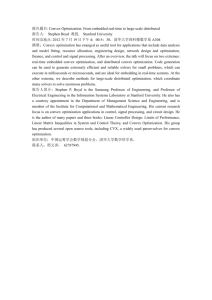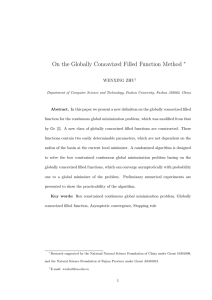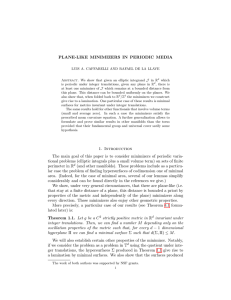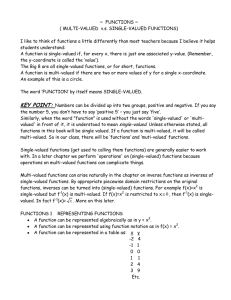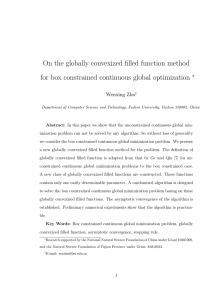IEOR 265 – Lecture 12 Parametric Optimization 1 Definitions
advertisement
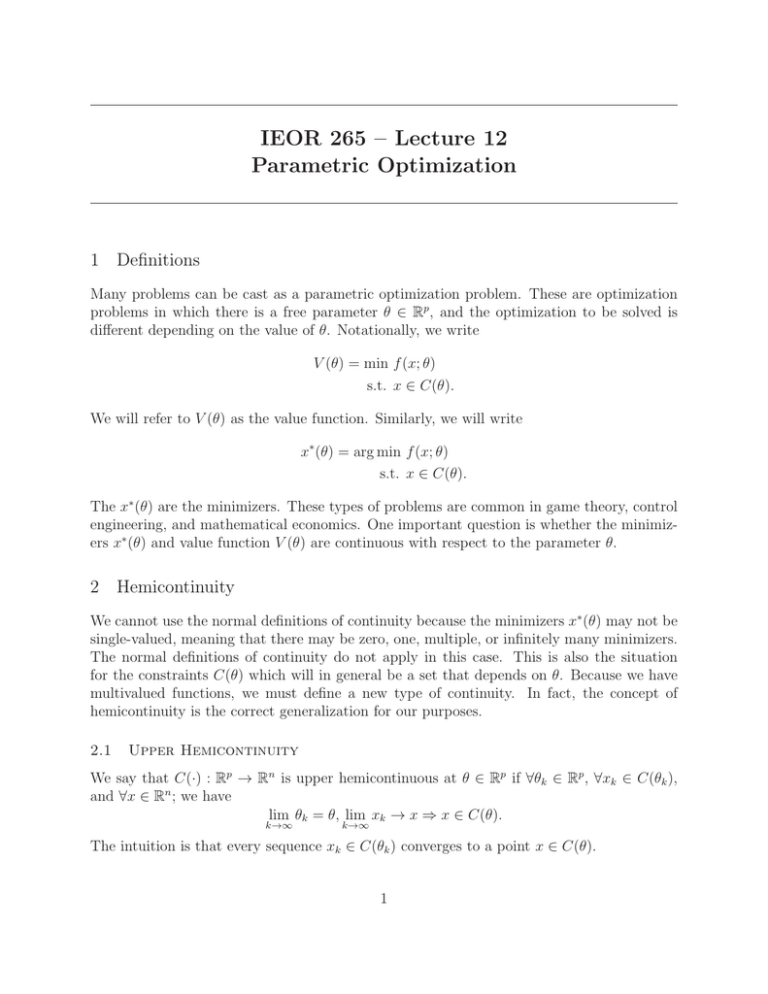
IEOR 265 – Lecture 12
Parametric Optimization
1 Definitions
Many problems can be cast as a parametric optimization problem. These are optimization
problems in which there is a free parameter θ ∈ Rp , and the optimization to be solved is
different depending on the value of θ. Notationally, we write
V (θ) = min f (x; θ)
s.t. x ∈ C(θ).
We will refer to V (θ) as the value function. Similarly, we will write
x∗ (θ) = arg min f (x; θ)
s.t. x ∈ C(θ).
The x∗ (θ) are the minimizers. These types of problems are common in game theory, control
engineering, and mathematical economics. One important question is whether the minimizers x∗ (θ) and value function V (θ) are continuous with respect to the parameter θ.
2 Hemicontinuity
We cannot use the normal definitions of continuity because the minimizers x∗ (θ) may not be
single-valued, meaning that there may be zero, one, multiple, or infinitely many minimizers.
The normal definitions of continuity do not apply in this case. This is also the situation
for the constraints C(θ) which will in general be a set that depends on θ. Because we have
multivalued functions, we must define a new type of continuity. In fact, the concept of
hemicontinuity is the correct generalization for our purposes.
2.1
Upper Hemicontinuity
We say that C(·) : Rp → Rn is upper hemicontinuous at θ ∈ Rp if ∀θk ∈ Rp , ∀xk ∈ C(θk ),
and ∀x ∈ Rn ; we have
lim θk = θ, lim xk → x ⇒ x ∈ C(θ).
k→∞
k→∞
The intuition is that every sequence xk ∈ C(θk ) converges to a point x ∈ C(θ).
1
2.2
Lower Hemicontinuity
We say that C(·) : Rp → Rn is lower hemicontinuous at θ ∈ Rp if ∀θk ∈ Rp such that θk → θ,
∀x ∈ C(θ), there exists a subsequence θkj and xk ∈ C(θkj ) such that xk → x. The intuition
is that for every point x ∈ C(θ) there is a sequence xk ∈ C(θk ) that converges to the point.
2.3
Examples
There are two important examples of constraint sets for which C(θ) is both upper and lower
hemicontinuous. The first example is when the constraint set is independent of θ. The
second example is when the constraint set is linear in both x and θ.
3 Berge Maximum Theorem
The Berge Maximum Theorem provides an interesting set of conditions for when the minimizers and value function are appropriately continuous. The reason for stating appropriately
continuous is that the function C(θ) is not a function in the normal sense; it is a multivalued
function, and so continuity has to be redefined as above. The intuition of the theorem is
that if the objective is continuous in the usual way, and the constraint set is continuous in
an appropriate way, then the value function is continuous and the minimizer is continuous
in an appropriate way. More formally:
If f (x; θ) is jointly continuous in x, θ and C(θ) is compact-valued, lower hemicontinuous, and
upper hemicontinuous, then the value function V (θ) is continuous and the minimizer x∗ (θ)
is nonempty, compact-valued, and upper hemicontinuous.
There is an important note: Upper hemicontinuity at a point that is single-valued means
that the function is continuous (in the traditional sense) at that point. As a result, if the
minimizer x∗ (θ) is single-valued, then the function is continuous at x∗ (θ).
3.1
Variants
If the objective f (x, θ) is convex in (x, θ) and the graph of C(θ) (meaning the set {(x, θ) :
x ∈ C(θ)}) is convex, then the value function V (θ) is convex. Furthermore, if f (x, θ) is
strictly convex in (x, θ) and the graph of C(θ) is convex, then the value function V (θ) is
convex and the minimizer x∗ (θ) is single-valued and continuous in θ. Note that in general
for both situations, x∗ (θ) will not be convex in θ.
2


